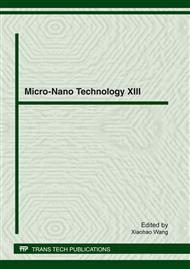p.12
p.18
p.24
p.29
p.35
p.43
p.49
p.55
p.61
New Isolation Optimization Method of RF MEMS Capacitive Switches
Abstract:
A new isolation optimization method of radio frequency (RF) microelectromechanical systems (MEMS) capacitive switches is carried out in this paper. We simplified the coplanar waveguide and the top movable electrode as two-port network. The existence of the maximum isolation of single switch is proved theoretically based on circuit model and S-parameters model. The isolation of the distributed switches with lossless transfer lines, which is the function of the transfer lines length and the impedance of metal beams, is described by mathematic expressions and simulated in a numerical method. We find that the isolation varies periodically with θ and f, which are the electrical length between metal beams of the distributed switches and the signal frequency. It achieves the maximum value 83dB at θ=π/2 for 2-beams switch. However, different from single beam switches, the distributed switches maximum isolation is near but not precisely at the resonance frequency f0. The bandwidth of RF signal can be widened to about 200% for 5-beams switch by using the proposed design method. The results will be useful for Resistance-Inductance- Capacitance parameters optimization of RF MEMS Capacitive switches.
Info:
Periodical:
Pages:
35-42
Citation:
Online since:
February 2012
Authors:
Price:
Сopyright:
© 2012 Trans Tech Publications Ltd. All Rights Reserved
Share:
Citation:


